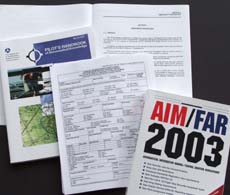| Advertisers
               
Do not reply to this e-mail. Got news? Contact ePilot. Having difficulty using this service? Visit the ePilot Frequently Asked Questions now at AOPA Online or write to [email protected].
Aircraft Owners and Pilots Association
421 Aviation Way
Frederick, MD 21701
Tel: 800/USA-AOPA or
301/695-2000
Copyright � 2002 AOPA. | Training Tips
| RESPONSIBILITIES OF THE PILOT IN COMMAND
 The pilot in command of an aircraft is responsible for the safety of a flight, and has authority to deviate from the federal aviation regulations (FARs) to the extent necessary to meet an emergency. This is embodied in FAR 91.3(b). The pilot must also know the procedures to follow in the event of a mishap. Doing so requires complying with regulations enforced by another federal agency, the National Transportation Safety Board. See the NTSB's discussion of its reporting requirements on its aviation Web site. The pilot in command of an aircraft is responsible for the safety of a flight, and has authority to deviate from the federal aviation regulations (FARs) to the extent necessary to meet an emergency. This is embodied in FAR 91.3(b). The pilot must also know the procedures to follow in the event of a mishap. Doing so requires complying with regulations enforced by another federal agency, the National Transportation Safety Board. See the NTSB's discussion of its reporting requirements on its aviation Web site.
The relevant regulatory section is brief but important. Questions about it may be encountered on the Private Pilot Knowledge Test. NTSB Part 830 could also be a subject of questions by your flight-test examiner. Basically, a pilot must know what–and when–he or she must report about any accident or incident that occurred during a flight. Written reports, when required, must be filed on the seven-page NTSB Form 6120 ( click here to download). Study the definitions in the regulatory section cited above. Then review such test questions as the following:
The operator of an aircraft that has been involved in an accident is required to file an accident report within how many days?
A. 5.
B. 10.
C. 7.
Another function of the NTSB is to act as an independent arbiter in appeals of disciplinary or certificate actions against a pilot by the FAA. But this role is constrained by legal precedents, especially concerning the FAA's interpretation of the regulations in publications many pilots still regard only as non-regulatory "guidance." This complicated area of administrative law is clarified in attorney Kathy Yodice's "Legal Briefing" in the September 2002 AOPA Flight Training.
The conscientious pilot, therefore, should be thoroughly familiar with the procedures set out in such publications as the Aeronautical Information Manual . The foregoing is a good reason for a student pilot to enroll in the AOPA Legal Services Plan, which provides AOPA members with expert representation by attorneys experienced in aviation legal matters. See how the plan has been expanded and improved to serve today's pilots in the "Pilot Counsel" column in the August 2000 AOPA Pilot. Then enjoy your flying, secure in the knowledge that you have the latest information and best protection available to any pilot.
| Your Partner in Training
| To help pilots, student pilots, and instructors to better understand runway signage, the AOPA Air Safety Foundation–supported by a grant from the FAA–has produced a new runway incursion training program using a decidedly low-tech approach: flash cards ( click here to download). These flash cards will be especially helpful for pilots training at smaller, nontowered airports as they prepare to fly into often, towered facilities.
As an AOPA Flight Training Member, you have access to all of the features within AOPA Online. For login information click here.
| Flight Training News
| WARRIOR SIMULATOR RECEIVES FAA APPROVAL
For the first time, aircraft reference data for the Piper Warrior–a popular training aircraft–has been approved by the FAA. Vector Training Systems in Grand Forks, North Dakota, independently flight-tested Piper Warriors to obtain the data, which was OKed by the FAA's National Simulator Program. The approval means that flight schools operating Vector's Piper Warrior flight training devices (FTDs) may work with their local FAA office to receive FAA Level 3 approval of the simulators. Vector has delivered two Piper Warrior FTDs to the John D. Odegard School of Aerospace Sciences at the University of North Dakota, which expects to receive FAA Level 3 approval later this month.
ZERO-G FLIGHTS OFFERED NEXT YEAR
Ever think you might like to be an astronaut? A new company with headquarters in Los Angeles can sell you a taste of weightlessness. Zero Gravity Corporation will begin offering such flights in the United States in early 2003. Using a Boeing 727 cargo aircraft, the firm will fly space adventurers during the day and return the aircraft to a contract cargo carrier during the night. The company is betting on corporate clients like Hollywood movie producers to provide the profits, but will make flights available to individuals as well. A ticket to ride will cost between $3,500 and $5,000. Weightlessness is achieved by pulling the aircraft up 45 degrees, then nosing over to duplicate zero-G conditions for 30 seconds–and doing it again and again–for up to 30 passengers. For information, see the company's Web site.
| Inside AOPA
| FAA OPINION SUPPORTS AOPA's LAWSUIT AGAINST MICHIGAN
In response to a request from AOPA’s general counsel, the FAA has issued a legal opinion that state and local governments cannot pass laws regulating pilot certification. The FAA said specifically that state laws requiring student pilot background checks “would likely intrude into an area that Congress has preempted.” The opinion letter will be filed today with the federal district court in Detroit to support AOPA’s lawsuit against Michigan’s requirement for student-pilot background checks. “This letter is important ammunition in our lawsuit,” said AOPA President Phil Boyer. “The FAA says clearly that only the federal government can regulate pilot certification.” Boyer noted that the issue is not about aviation security; AOPA supports reasonable, effective measures on the national level to enhance security. The issue is really about state and local governments attempting to illegally control who can fly in the nation’s airspace. A public hearing is scheduled for October 29 on AOPA’s request for a preliminary injunction that would halt the background checks until the court hears the case.
CONGRESSMAN OFFERS PRAISE FOR AOPA'S EFFORTS
AOPA President Phil Boyer recently received a pleasant surprise when an unsolicited letter of thanks and support arrived by fax from Rep. Leonard Boswell (D-Iowa), an AOPA member and respected member of the House Transportation and Infrastructure Committee. "I wish to take this opportunity to thank you," said Boswell in his letter. "What you do is so important to all Americans." See AOPA�Online.
Changing your mailing or e-mail addresses? Click here to update.
| Training Products
| KERSHNER'S INSTRUCTOR MANUAL, UPDATED
Nationally renowned flight instructor, aviator, and aviation author William K. Kershner has released the newly updated fourth edition of The Flight Instructor's Manual. A pilot for more than 57 years, Kershner has also written popular manuals for student pilots, aerobatic and instrument flight, and advanced pilots. The 480-page book is available for $39.99 from Iowa State Press online or by calling 800/862-6657.
| Final Exam
| Question: What are the minimum requirements for a pilot to act as safety pilot for another pilot practicing instrument procedures, while operating VFR?
Answer: The safety pilot must be at least a private pilot, rated in the appropriate category and class of the aircraft in which he or she is acting as safety pilot (14 CFR 91.109[b]) and hold a current medical (14 CFR 61.3[c]). For more information, you may want to read "Pilot Counsel: Unusual Regs" and "Logging Time: Safety Pilot."
Got a technical question for AOPA specialists? E-mail to [email protected] or call 800/872-2672.
| Picture Perfect
| | Jump to the AOPA Online Gallery to see the featured airplane of the day. Click on the link for details on how to capture wallpaper for your work area. See AOPA Online.
| What's New At AOPA Online
| We've updated AOPA Flight Training's Online Resources for Student Pilots page with new links to information that will be helpful to student and new pilots. Check out this handy reference on AOPA Online–and bookmark it for future reference!
| Weekend Weather
| See the current weather on AOPA�Online, provided by Meteorlogix.
| ePilot Calendar
| WEEKEND FLYING DESTINATIONS
Palm Springs, California. AOPA Expo 2002 takes place October 24 through 26 at the Palm Springs Convention Center in California. For complete details, visit the Web site.
For more airport details, see AOPA's Airport Directory Online . For more events, see Aviation Calendar of Events.
ASF FLIGHT INSTRUCTOR REFRESHER CLINICS
(All clinics start at 7:30 a.m.)
The next AOPA Air Safety Foundation Flight Instructor Refresher Clinics are scheduled in Windsor Locks, Connecticut; Columbia, South Carolina; and Reston, Virginia on October 26 and 27. A clinic is also scheduled in Dallas/Fort Worth, Texas, on November 2 and 3. For the Flight Instructor Refresher Clinic schedule, see AOPA Online.
ASF PINCH-HITTER GROUND-SCHOOL COURSES
(Pinch-Hitter courses start at 9:30 a.m.)
The next Pinch-Hitter� Ground School will take place in Windsor Locks, Connecticut, October 27. For more Pinch-Hitter courses, see AOPA Online.
ASF SAFETY SEMINARS
AOPA Air Safety Foundation Safety Seminars are scheduled in Palm Springs, California, October 24 through 26. Topics vary, check AOPA�Online for the complete schedule and topic listing.
To make submissions to the calendar, visit AOPA Online. For comments on calendar items, e-mail [email protected].
| |